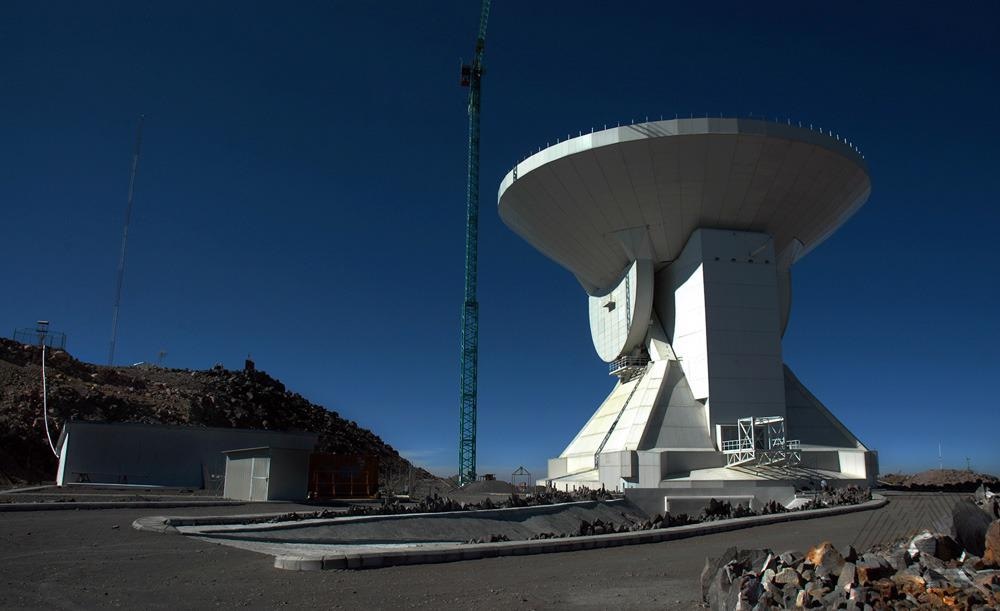Mar 15 2021
Huge reservoirs of molecular gas are found in ultraluminous infrared galaxies (ULIRGs), which are powered by starburst activity and usually with supermassive black holes that tend to accumulate material at their nuclei.
 The Large Millimeter Telescope Alfonso Serrano (LMT), the world’s largest single-dish steerable millimeter-wavelength telescope. Astronomers have used this newly operational facility to study the dense, star-forming molecular gas in a torus around the nuclear region of the ultraluminous infrared galaxy UGC5101, and conclude that the gas is in Keplerian motion with the densest material at the innermost radii. Image Credit: Center for Astrophysics.
The Large Millimeter Telescope Alfonso Serrano (LMT), the world’s largest single-dish steerable millimeter-wavelength telescope. Astronomers have used this newly operational facility to study the dense, star-forming molecular gas in a torus around the nuclear region of the ultraluminous infrared galaxy UGC5101, and conclude that the gas is in Keplerian motion with the densest material at the innermost radii. Image Credit: Center for Astrophysics.
Scientists expect that molecular gas forms the raw material for new stars and the occurrence of the infrared luminous warm dust indicates an abundance of molecular gas. Collisions between galaxies often induce star formation activity. Simulations by researchers have shown that when two galaxies merge, their gas falls toward the nuclear region and tends to develop into a disk with a radius of about 1500 light-years.
Several such galaxies have been found to have powerful circumnuclear starbursts, seemingly as a consequence. The occurrence of the carbon monoxide (CO) gas in ULIRGs—a plentiful yet low-density molecular species—has in fact offered proof for circumnuclear disks in the wide range of velocities exhibited by the gas, which is the property of rotating disks.
But astronomers are aware that star formation needs the presence of gas 10–100 times denser compared to that traced by CO. They are not sure about how the denser material is distributed, as well as the role played by the active nucleus in shaping the disk.
The newly built and completed Large Millimeter Telescope Alfonso Serrano (LMT) is the largest single-dish, steerable, submillimeter-wavelength telescope in the world (with a diameter of 50 m). It is a binational project between the United States and México.
The submillimeter wavelengths are perfect for analyzing the dense, cool molecular gas in species such as CS and HCN. Giovanni Fazio, a CfA astronomer, was a member of a team that employed the LMT to investigate the dense molecular gas in the circumnuclear disk in the ULIRG UGC5101.
Nine molecules were found by the astronomers and these dense gas tracers also revealed wide velocity profiles ranging to about 800 km/second, all exhibiting the double-peak shape property of viewing a rotating torus slightly edge-on.
When gravitational forces dominate the rotation of a disk, its material travels based on Kepler’s laws (the same laws also govern the orbits of planets), where the innermost material orbits fastest—this behavior is in contrast to the case of a rigid rotating disk.
In conclusion, the researchers note that the circumnuclear disk in UGC5101 follows Keplerian behavior, and since the different molecules trace material with somewhat different density, the Keplerian velocity of each species can be used to model the density distribution across the disk, where the inner regions with a higher density move faster.
The new outcome, which is one of the first for the new LMT, enables performing a detailed model of the structure of the circumnuclear starburst ring, the evolution of its merger, and its interplay with the active nucleus.
Journal Reference:
Cruz-González, I., et al. (2021) Early science with the LMT: molecular torus in UGC 5101. Monthly Notices of the Royal Astronomical Society. doi.org/10.1093/mnras/staa2949.